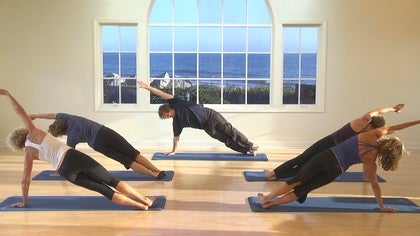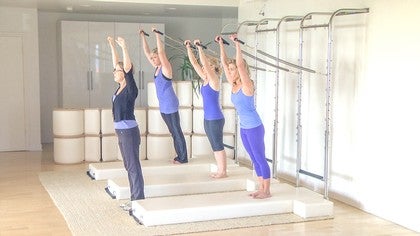Tutorial #877
Advanced Mat Variations
Description
About This Video
Transcript
Read Full Transcript
We just going to go over, um, five exercises that might make us get into trouble as we do them. Um, so it's more of a safety issues and we want to make sure that everybody knows what we want them to do so nobody gets hurt. So the first one is the, the first one is the rollover. The version we're going to do in class today goes over and touches the floor and you open your legs wide. Number one, if you can't touch the floor with keeping your hips right over your shoulders, you can't do this one plain and simple. You can't do it. Don't try, don't do it. If, however you can just to explain it, you want to just do it, I'll pay later. So he loves this one rolling over.
He keeps his hips right above his shoulders. He touches a far Yay. So that means he can open his legs as wide as possible and we mean as wide as possible. And then he rolls down that way. That clear. I'm not going to make you guys do it cause you're not warm. You'll have three exercises in front of this to warm up. Ooh. Then we reverse this and you open wide, get skinny and brewing it up and over, keeping the legs wide.
Then bring it together just because there's a, you know, whole thing contra-indicated about the weight. What causes the way it is when your hips go past the shoulders, not necessarily so much the legs. That's it in a nutshell. Then the next one is the leg pole from an our leg. Paul, no leg circles. So that's where my notes are here cause I didn't want to remember which ones were doing so you can all lie down for this one.
That way when we get to the class you look really good. Flex the left foot, point the right foot. Now what you're going to do for the like circles, you're going to inhale, bring that right leg up. On the exhale you're going to cross the body, allowing the hip to come up. The trick is to stay in square key both shoulders on the mat so your hip can only go as far as you can maintain your shoulders and that lovely long neck that you have. Perfect. That's one way we do it that way only. So we were up here, I'm just gonna use you because you're in front cross, cross, cross, cross five times. We bring this down. You as you can cross the body as far as you can. Keep both shoulders down.
Yes. So it limited. A lot of people take their hips off and the shoulders go and everything goes and they lose control of the whole exercise. And to quote Joe in the favorite bestseller that everybody keeps rereading the shoulders, he says and need to maintain contact with the mat on the floor. So keep that from there. We do that then to the other side. So you would bring that right foot down, you flex it, point the other one, and then inhale, bring it up, exhale, cross the body and then inhale, bring it up that five times.
Bring that down. Here's the part that you really want to look good. And we've done that five. Now we're going to reverse it. So you flex the left point, the right, and this is again, always just think inhale, cross the body. So she inhales crossing, the hip goes off again, keeping both shoulders coming back to center and exhale, bring it back down. Make sense to recap the leg circles to answer your question. So you're here, you start flex, one foot. Other one points.
You're going to inhale up from here. You're going to exhale down. Inhale back up five times. Bring it down. Flex that foot. Point that one. Inhale. Exhale. Inhale up. Five times done. Flex the foot point.
This time it starts from the bottom. You inhale, exhale, back and around. Up. Then bring that foot down. Flex that foot. Point. This one, bring it up. Is that clear? Clear. That's cause you're also smart, clear as mud, as thick as mud. Two questions. So we did those two, right? Yes.
So if you're going into the position from here, you can drill back and if you really open your legs wide, you can touch and your head will stay off the floor, right? But make sure that you leg stay nice and wide. If you feel yourself losing control, which might happen and you start to slowly go back to your normal position. If you have your legs here not so wide, you see that I have to walk a lot further to get my feet on my floor on the floor. And that's when you get into trouble with your neck. So if you don't have the flexibility to be that wide or you don't have the control to be that wide, you should not touch the floor. You can only touch the floor if your legs are really wide open.
That makes sense. So just be aware of that when we get there. The
The going down part that it is, and this is also how she would help you. So I might as well do that. She wouldn't wrap underneath the arms and pull you up so you get a nice little traction. Now the whole idea is, is that you roll down through your spine, but only one further bread at the time. The rest stays straight. So he curls the first six under and then so he still rolls. But since the rest of his body is straight, it looks like a hinge, but it's not a hinge. It's still rolled, if that makes sense.
That makes sense. So it's still articulation through the spine, like any other neck pool except for you try to keep everything straight and eventually the leverage gets a little long and that's where you get into trouble. Very nice. Right? So you tried to stay as long as possible but still articulate through your spine. That makes sense. I'm good. Then uh oh the crab. So let's go over to crap. They had many, many different versions of the crap. That's why we want to take your time to go over and now they'll like this one.
This one is not so bad or let me say their worst. Um, your corrupt shit legs and your hold onto your toes. You want to be as tight as possible. Now in this grab, you might've done a version where you go back and you switch legs. In this version you don't, right? So wherever your hold on, that's where you hold on. So we roll back in this position and we stay here. Now you roll over to you and to your knees.
Now your feet in this version stay on the floor. You place the head down and you lift up and around. So it's a lot wider base because you have your feet, your knees, and your head on the mat. And actually the center is in this, in the middle of your body weight. So there's not as much pressure on your head because it's almost like something is cooling your straight up, not over. Do not go forward. Go up and just relax back down.
And when we get there, make sure you have enough room for your head to be on the Mat, right? So make sure, Oh, don't change your legs in this version. The feet don't change. Um, you want to make sure that you scoop in the ribs up so that the action is up to the ceiling and not keep going forward. That's where the control comes in. That makes sense. So make sure that after you come here, you place your head down that from here you don't keep going that direction because that's when the neck gets into trouble. You want to place the head down and from here it goes straight up.
Right? Almost like a, um, sort of like a cat stretch, right? The rounded part of the cat stretch or camel, whatever you want to think. Exactly. So when you're on your head, the neck is basically in this position only upside down. Right? So your neck is long, so that's why not crunched. Not that's where you end up on. Yes. Yes. So you might have to place your head a little bit more here and then you roll the rest of the part. It makes sense. It's not all the way to, not all the way to front head because it's a, um, you know what I mean?
You'll probably end up being a little bit more over here, and then you roll up right on the top of the crown because the feet don't go with you. So you don't roll as much as with the other versions. So, um, any questions on those before we go and party? Let's party in.
The Teacher's Corner: Archival Workouts
Comments
You need to be a subscriber to post a comment.
Please Log In or Create an Account to start your free trial.










